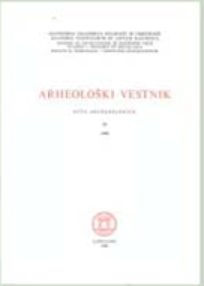The Graves of Vinča
Abstract
In Vasić’s w orks m any of Ms hypotheses are based on graves w hich he says to have been discovered in the c a ttu rai stra ta of the prehistoric settle[1]m ent of Vinca. It was positively stated th a t in the low est stratu m in one of th e dw elling caves 9 skeletons and some fragm ents of o th er ones hacl been excavated. O riginally, Vasić considered th a t dw elling cave to have been a special se[1]pulchre, a so-called cham ber tomb. O n som e skeletons th ere are traces of a p artial carbonization, especially on the skull of skeleton No. 1 . O ver such carbonized p arts a carbonized beam was lying w hich was a p a rt of the wooden construction of the dw elling cave. T herefore Vasić m eans th a t there m ust have been inhum ed both crem ated and not crem ated corpses, w hich is wrong. The traces of fire are of a la te r period w hen the dw elling cave was used as a tomb, or burnt by accident. Pieces of burning beams had fallen on the corpses or skeletons, aind left their traces on some of their parts. Over that dwelling cave which was used as a sepulchre there is a thiiT[1]ner stratum of pure loess, and above (it a new humic layer mixed with crushed charcoal and ashes. This is the reason why Vasić states that over the mass grave there was a cult fire burning. Yet that (statement is wrong, the remains being of the burnt wooden construction or offal and ashes from the neigh[1]bouring cultural caves. Another positively stated grave is the one with a skeleton in contracted attitude in another dwelling cave. The third grave does not belong to the Vinca culture period any more, but to all appearance to the la Tène period; it was found in more recent layers. As far as we know at present those are the only graves that have been excavated at Vinča. Yet in the layer of Vinca there are several fragments of human skulls, especially in the lower strata. They probably belong to earlier graves which were later destroyed while various works were being undertaken on the spot. Vasić supposes th at there were more ways of interment. Thus he thinks that a considerable number of pithoi which have been found in fragments had served for interments. Another way of inhuming may have been the burying of cremated corpses in urns. As urns may have served two comical (fragmentary) vases witli reliefs, anthropomorphic vases with prosopomorphic lids, anthropomorphic vases without lids and other vases, etc. Yet all of them are represented only by fragments, sometimes even by quite slight ones. Besides, in connection with such vases neither human cremated bones nor any other traces of a cremated corpse have ever been found. It is true that in Vasić’s opinion any layer of ashes belongs to a cremated corpse, yet there are at the same time no burnt bones which might, be expected. The fragmen[1]tary human skull which he mentions to have been discovered in the layer of ashes in 1934, and other fragments of calcified bones do not belong to a cre[1]mated corpse, but are the remains of some later turned up skeleton grave. Also in another case, mentioned by him, namely that in the layer of dwelling caves a biconical vase with ashes and calcified bones has been found, the finding does not seem to be really a cremated inhumation, as it was stated neither what kind, of ashes nor what kind of bones it was, and whether they were really remains of human bones or not. F u rth e r Vasić supposes there w ere some m ore ways of burying: a kind of larnaces consisting of perforated oval clay plates and shallow oval dishes. The longest dish, how ever, was h ard ly 0,5 m long and a few centim etres high. N ow adays it is impossible to explain to w hat purpose the oval plates served (their size is up to 45 cm, but also much sm aller), w hile the dishes represent sim ply pottery for everyday use. Besides, the plates are never found in any connection w ith the pottery, and are usually in small fragm ents only. In his opinion there was another special way of burying, the »shaft graves*, the proof of their existence being statuettes the fragments of which graves«, the proof of their existence being statuettes the fragments of which various fissures in that area or cultural caves, etc. The biggest amphora that has been discovered up to the present at Vinca is in Vasić’s opinion not a grave, it is true, but a tombstone anyhow. It was excavated in a house whiclf is being considered a sepulchre now. Also1 other objects found in the same house, objects of everyday life, have been explained to be grave accessories. As a m atter of fact the amphora represents a store vessel, which is to be seen by its manufacture, despite of its anthropomorphic representations. At Vinca we have thus only some specimens of skeleton graves in the lowest strata; and there are no traces of cremated corpses. The necropolis of Vinca must have been in another place
Downloads
Downloads
Published
How to Cite
Issue
Section
License

This work is licensed under a Creative Commons Attribution-NonCommercial-ShareAlike 4.0 International License.
Authors guarantee that the work is their own original creation and does not infringe any statutory or common-law copyright or any proprietary right of any third party. In case of claims by third parties, authors commit their self to defend the interests of the publisher, and shall cover any potential costs.
More in: Submission chapter





